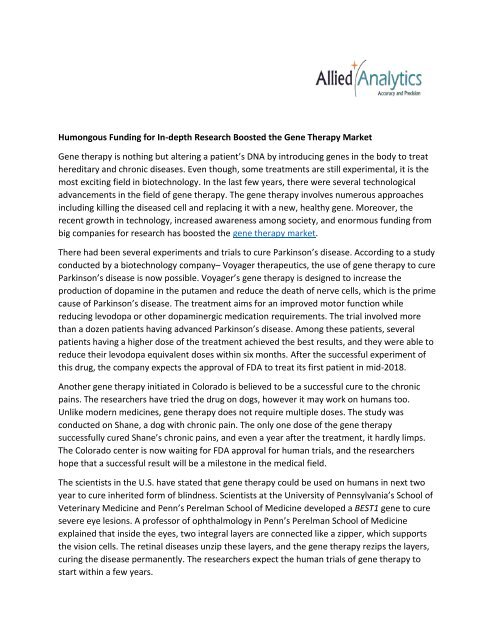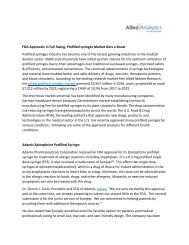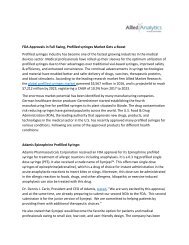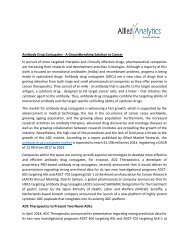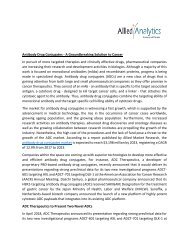Humongous Funding for In-depth Research Boosted the Gene Therapy Market
Over the recent years, the demand for gene therapy is on a rapid increase. With the advancement in technology, the gene therapy market has transformed during the recent few years. Gene therapy is a technique used for the treatment of cancer where therapeutic DNA is being introduced into the gene of the patient with cancer. The global gene therapy market was valued at $584 million in 2016, and is estimated to reach $4,402 million by 2023, registering a CAGR of 33.3% from 2017 to 2023.
Over the recent years, the demand for gene therapy is on a rapid increase. With the advancement in technology, the gene therapy market has transformed during the recent few years. Gene therapy is a technique used for the treatment of cancer where therapeutic DNA is being introduced into the gene of the patient with cancer.
The global gene therapy market was valued at $584 million in 2016, and is estimated to reach $4,402 million by 2023, registering a CAGR of 33.3% from 2017 to 2023.
You also want an ePaper? Increase the reach of your titles
YUMPU automatically turns print PDFs into web optimized ePapers that Google loves.
<strong>Humongous</strong> <strong>Funding</strong> <strong>for</strong> <strong>In</strong>-<strong>depth</strong> <strong>Research</strong> <strong>Boosted</strong> <strong>the</strong> <strong>Gene</strong> <strong>Therapy</strong> <strong>Market</strong><br />
<strong>Gene</strong> <strong>the</strong>rapy is nothing but altering a patient’s DNA by introducing genes in <strong>the</strong> body to treat<br />
hereditary and chronic diseases. Even though, some treatments are still experimental, it is <strong>the</strong><br />
most exciting field in biotechnology. <strong>In</strong> <strong>the</strong> last few years, <strong>the</strong>re were several technological<br />
advancements in <strong>the</strong> field of gene <strong>the</strong>rapy. The gene <strong>the</strong>rapy involves numerous approaches<br />
including killing <strong>the</strong> diseased cell and replacing it with a new, healthy gene. Moreover, <strong>the</strong><br />
recent growth in technology, increased awareness among society, and enormous funding from<br />
big companies <strong>for</strong> research has boosted <strong>the</strong> gene <strong>the</strong>rapy market.<br />
There had been several experiments and trials to cure Parkinson’s disease. According to a study<br />
conducted by a biotechnology company– Voyager <strong>the</strong>rapeutics, <strong>the</strong> use of gene <strong>the</strong>rapy to cure<br />
Parkinson’s disease is now possible. Voyager’s gene <strong>the</strong>rapy is designed to increase <strong>the</strong><br />
production of dopamine in <strong>the</strong> putamen and reduce <strong>the</strong> death of nerve cells, which is <strong>the</strong> prime<br />
cause of Parkinson’s disease. The treatment aims <strong>for</strong> an improved motor function while<br />
reducing levodopa or o<strong>the</strong>r dopaminergic medication requirements. The trial involved more<br />
than a dozen patients having advanced Parkinson’s disease. Among <strong>the</strong>se patients, several<br />
patients having a higher dose of <strong>the</strong> treatment achieved <strong>the</strong> best results, and <strong>the</strong>y were able to<br />
reduce <strong>the</strong>ir levodopa equivalent doses within six months. After <strong>the</strong> successful experiment of<br />
this drug, <strong>the</strong> company expects <strong>the</strong> approval of FDA to treat its first patient in mid-2018.<br />
Ano<strong>the</strong>r gene <strong>the</strong>rapy initiated in Colorado is believed to be a successful cure to <strong>the</strong> chronic<br />
pains. The researchers have tried <strong>the</strong> drug on dogs, however it may work on humans too.<br />
Unlike modern medicines, gene <strong>the</strong>rapy does not require multiple doses. The study was<br />
conducted on Shane, a dog with chronic pain. The only one dose of <strong>the</strong> gene <strong>the</strong>rapy<br />
successfully cured Shane’s chronic pains, and even a year after <strong>the</strong> treatment, it hardly limps.<br />
The Colorado center is now waiting <strong>for</strong> FDA approval <strong>for</strong> human trials, and <strong>the</strong> researchers<br />
hope that a successful result will be a milestone in <strong>the</strong> medical field.<br />
The scientists in <strong>the</strong> U.S. have stated that gene <strong>the</strong>rapy could be used on humans in next two<br />
year to cure inherited <strong>for</strong>m of blindness. Scientists at <strong>the</strong> University of Pennsylvania’s School of<br />
Veterinary Medicine and Penn’s Perelman School of Medicine developed a BEST1 gene to cure<br />
severe eye lesions. A professor of ophthalmology in Penn’s Perelman School of Medicine<br />
explained that inside <strong>the</strong> eyes, two integral layers are connected like a zipper, which supports<br />
<strong>the</strong> vision cells. The retinal diseases unzip <strong>the</strong>se layers, and <strong>the</strong> gene <strong>the</strong>rapy rezips <strong>the</strong> layers,<br />
curing <strong>the</strong> disease permanently. The researchers expect <strong>the</strong> human trials of gene <strong>the</strong>rapy to<br />
start within a few years.
Apart from such animal experiments, in March 2018, a human trial was conducted using gene<br />
<strong>the</strong>rapy. A teenager was cured of sickle-cell disease owing to an experimental gene <strong>the</strong>rapy at<br />
Necker Children's Hospital in Paris. The presence of abnormal hemoglobin in red blood cells<br />
(RBCs) causes sickle cell disease, which results in clots in tiny vessels and various organs of <strong>the</strong><br />
body. Worldwide, more than 200,000 infants are born with sickle cell diseases, and <strong>the</strong><br />
successful experiment on human patients has relieved many patients and <strong>the</strong>ir parents.<br />
Fur<strong>the</strong>rmore, if <strong>the</strong> treatment shows successful results, <strong>the</strong> researchers want to use similar<br />
gene <strong>the</strong>rapy to cure thalassemia, ano<strong>the</strong>r inherited blood disorder.<br />
The recent developments and trials in gene <strong>the</strong>rapy showed <strong>the</strong> exponential growth of gene<br />
<strong>the</strong>rapy market in <strong>the</strong> recent years. <strong>In</strong> a recent report on gene <strong>the</strong>rapy market, Allied <strong>Market</strong><br />
<strong>Research</strong> analyzed market trends, and outlined that <strong>the</strong> market was valued at $584 million in<br />
2016, and is expected to reach $4,402 million by 2023, growing at a CAGR of 33.3% from 2017<br />
to 2023. The report offers Porter’s five <strong>for</strong>ces analysis, key segments, regions, drivers, restrains,<br />
and opportunities in <strong>the</strong> gene <strong>the</strong>rapy market. Moreover, it studies key market players and <strong>the</strong><br />
growth of <strong>the</strong> market in <strong>the</strong> regions such as North America, Europe, Asia-Pacific, and LAMEA.<br />
The report is beneficial <strong>for</strong> market players, business experts, and entry-level organization to<br />
understand <strong>the</strong> market trends and strategies to boost revenue.


